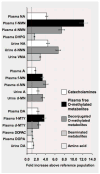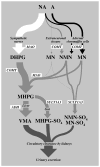Catecholamine metabolomic and secretory phenotypes in phaeochromocytoma
- PMID: 21051559
- PMCID: PMC3671349
- DOI: 10.1677/ERC-10-0211
Catecholamine metabolomic and secretory phenotypes in phaeochromocytoma
Abstract
Phaeochromocytomas and paragangliomas (PPGLs) are highly heterogeneous tumours with variable catecholamine biochemical phenotypes and diverse hereditary backgrounds. This analysis of 18 catecholamine-related plasma and urinary biomarkers in 365 patients with PPGLs and 846 subjects without PPGLs examined how catecholamine metabolomic profiles are impacted by hereditary background and relate to variable hormone secretion. Catecholamine secretion was assessed in a subgroup of 156 patients from whom tumour tissue was available for measurements of catecholamine contents. Among all analytes, the free catecholamine O-methylated metabolites measured in plasma showed the largest tumour-related increases relative to the reference group. Patients with tumours due to multiple endocrine neoplasia type 2 and neurofibromatosis type 1 (NF1) showed similar catecholamine metabolite and secretory profiles to patients with adrenaline-producing tumours and no evident hereditary background. Tumours from these three patient groups contained higher contents of catecholamines, but secreted the hormones at lower rates than tumours that did not contain appreciable adrenaline, the latter including PPGLs due to von Hippel-Lindau (VHL) and succinate dehydrogenase (SDH) gene mutations. Large increases of plasma dopamine and its metabolites additionally characterised patients with PPGLs due to the latter mutations, whereas patients with NF1 were characterised by large increases in plasma dihydroxyphenylglycol and dihydroxyphenylacetic acid, the deaminated metabolites of noradrenaline and dopamine. This analysis establishes the utility of comprehensive catecholamine metabolite profiling for characterising the distinct and highly diverse catecholamine metabolomic and secretory phenotypes among different groups of patients with PPGLs. The data further suggest developmental origins of PPGLs from different populations of chromaffin cell progenitors.
Figures

 ); for the deaminated catecholamine metabolites, including dihydroxyphenylglycol (DHPG), vanillylmandelic acid (VMA) and dihydroxyphenylacetic acid (DOPAC), by the medium grey bars (
); for the deaminated catecholamine metabolites, including dihydroxyphenylglycol (DHPG), vanillylmandelic acid (VMA) and dihydroxyphenylacetic acid (DOPAC), by the medium grey bars (
 ); and for the amino acid precursor of the catecholamines, dihydroxyphenylalanine (DOPA), by the light grey bar (
); and for the amino acid precursor of the catecholamines, dihydroxyphenylalanine (DOPA), by the light grey bar (
 ).
).

References
-
- Adams MS, Bronner-Fraser M. Review: the role of neural crest cells in the endocrine system. Endocr Pathol. 2009;20:92–100. - PubMed
-
- Aunis D, Langley K. Physiological aspects of exocytosis in chromaffin cells of the adrenal medulla. Acta Physiol Scand. 1999;167:89–97. - PubMed
-
- Brown MJ. Simultaneous assay of noradrenaline and its deaminated metabolite, dihydroxyphenylglycol, in plasma: a simplified approach to the exclusion of phaeochromocytoma in patients with borderline elevation of plasma noradrenaline concentration. Eur J Clin Invest. 1984;14:67–72. - PubMed
Publication types
MeSH terms
Substances
Grants and funding
LinkOut - more resources
Full Text Sources
Medical
Research Materials
Miscellaneous

